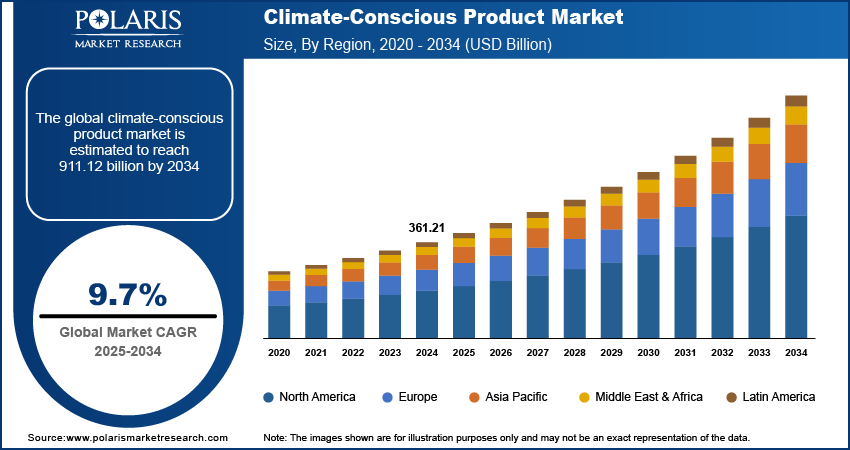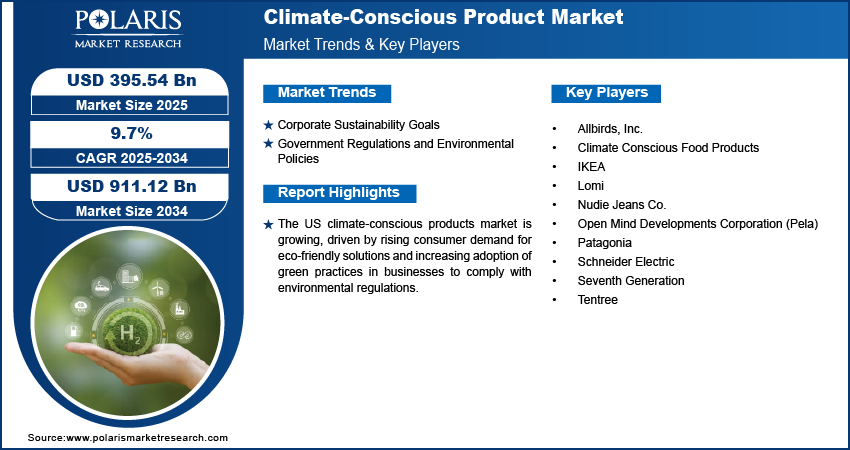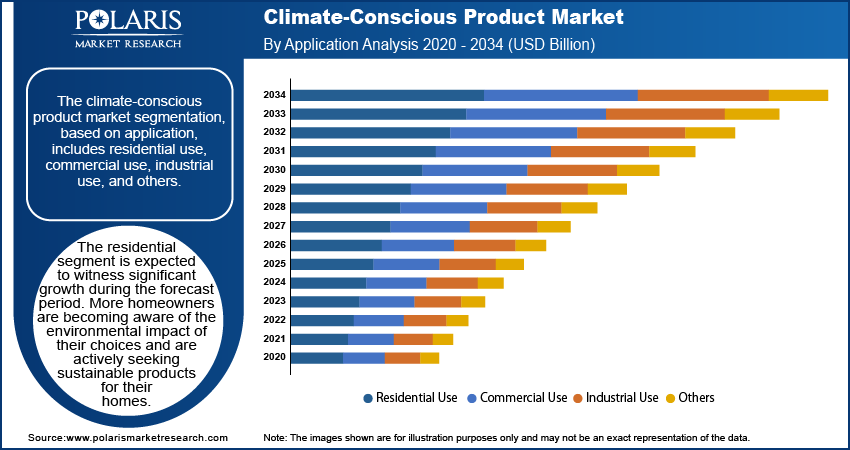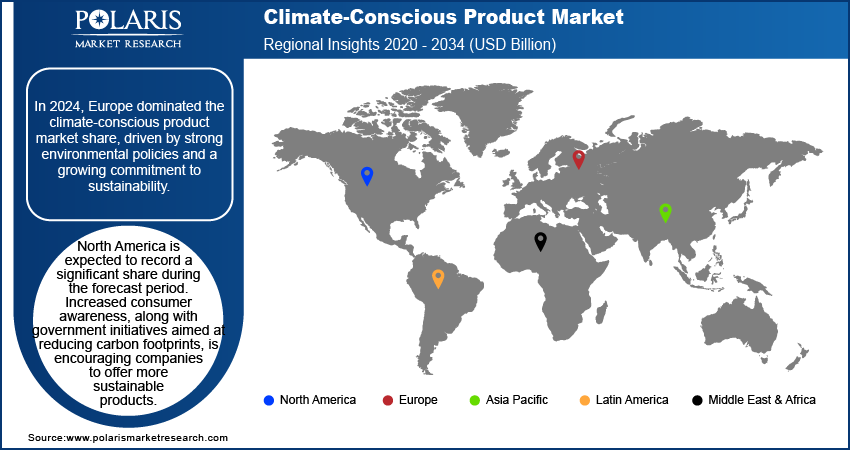
Climate-Conscious Product Market Size, Share, Trends, Industry Analysis Report
: By Product Type, Category, Application (Residential Use, Commercial Use, Industrial Use, and Others), and Region (North America, Europe, Asia Pacific, Latin America, and Middle East & Africa) – Market Forecast, 2025–2034
- Published Date:Aug-2025
- Pages: 125
- Format: PDF
- Report ID: PM5511
- Base Year: 2024
- Historical Data: 2020-2023
Market Overview
The climate-conscious product market size was valued at USD 361.21 billion in 2024, exhibiting a CAGR of 9.7% during 2025–2034. The market is driven by rising consumer demand for eco-friendly options, advances in sustainable technologies, corporate sustainability commitments, and stringent government regulations promoting environmental responsibility.
Key Insights
- The residential use segment is growing rapidly as homeowners seek energy-efficient appliances, sustainable furniture, and eco-friendly building materials to reduce their carbon footprint.
- Bio-compostable packaging leads the market due to rising consumer demand and strict regulations aimed at reducing plastic waste and environmental impact.
- Europe dominates the market, propelled by stringent environmental policies, carbon emission regulations, and high consumer awareness about sustainability.
- North America shows significant growth with government initiatives and increasing consumer demand driving the adoption of renewable energy, sustainable materials, and eco-friendly packaging.
Industry Dynamics
- Growing consumer awareness about environmental impacts is pushing demand for eco-friendly, sustainable products that minimize carbon footprints and waste.
- Technological advancements in energy-efficient manufacturing and sustainable materials reduce costs and improve accessibility of climate-conscious products.
- Increasing corporate sustainability commitments by major brands enhances reputation and encourages broader adoption of environmentally responsible products.
- Stricter government regulations worldwide compel businesses to adopt sustainable practices, driving market growth for climate-conscious products.
- High production costs and limited availability of sustainable raw materials hinder large-scale adoption of climate-conscious products.
Market Statistics
2024 Market Size: USD 361.21 billion
2034 Projected Market Size: USD 911.12 billion
CAGR (2025–2034): 9.7%
Europe: Largest market in 2024

To Understand More About this Research: Request a Free Sample Report
A climate-conscious product is designed with sustainability in mind, aiming to minimize its environmental impact throughout its lifecycle, from production to disposal. These products often incorporate eco-friendly materials, energy-efficient processes, and support for reducing carbon emissions.
Consumers are becoming more aware of how their purchasing decisions can adversely impact the environment. Media coverage about climate change, deforestation, and pollution has made people more conscious of the environmental footprint of the products they buy. Many actively seek out brands and products that are eco-friendly and sustainable. This shift in consumer preferences is pushing companies to adapt and offer products that align with the growing demand for sustainability. The rising popularity of climate-conscious products is encouraging businesses to create greener options to remain competitive and meet these evolving expectations, thereby driving the climate-conscious products market development.
Advances in technology are making climate-conscious products more accessible and affordable. Innovations such as energy-efficient manufacturing processes, sustainable materials, and renewable energy solutions are enabling companies to reduce their environmental impact. New biodegradable plastics and solar-powered technologies, for example, help reduce reliance on harmful resources. When these technologies become more efficient and cost-effective, companies can produce environmentally friendly products without compromising on quality or performance. This encourages businesses to develop and offer more sustainable options, driving the climate-conscious product market growth.
Market Dynamics
Corporate Sustainability Goals
Many brands are setting ambitious sustainability goals to improve their reputation and meet investor expectations. Large companies such as Adidas, H&M, Patagonia, and Schneider Electric have pledged to reduce their carbon footprint and use more sustainable materials in their offerings. According to H&M Group, the company pledges to reduce absolute greenhouse gas (GHG) emissions across value chain by 56% by 2030 and by at least 90% by 2040. Consumers, investors, and stakeholders are expecting businesses to show a genuine commitment to environmental and social responsibility. Brands that integrate sustainability into their supply chains gain customer trust and a competitive advantage. Companies that ignore this trend face criticism, boycotts, and declining customer loyalty, making sustainability not just a moral obligation but also a strategic business necessity. Hence, the corporate sustainability goals fuel the climate-conscious product market demand.
Government Regulations and Environmental Policies
Governments around the world are imposing stringent regulations to combat climate change and promote sustainability. These regulations often include targets for reducing carbon dioxide emissions, waste management, and using renewable energy sources. The United States Environmental Protection Agency (EPA) introduced regulations for household, industrial, and manufacturing solid and hazardous wastes under the Resource Conservation and Recovery Act (RCRA). To comply with these laws, businesses are increasingly adopting eco-friendly practices, such as using sustainable materials, reducing waste, and improving energy efficiency, thereby driving the climate-conscious products market expansion.

Segment Analysis
Market Assessment by Application Outlook
The climate-conscious product market segmentation, based on application, includes residential use, commercial use, industrial use, and others. The residential use segment is expected to witness significant growth during the forecast period. More homeowners are becoming aware of the environmental impact of their choices and are actively seeking sustainable products for their homes. This includes energy-efficient appliances, eco-friendly building materials, and sustainable furniture. The growing demand for green home solutions, driven by concerns over energy consumption and carbon footprints, is encouraging companies to innovate and offer more climate-conscious products tailored to residential needs, thereby driving the segment growth.
Market Evaluation by Category Outlook
The climate-conscious product market segmentation, based on category, includes recyclable products, compostable products, low-carbon footprint products, energy-efficient products, bio-compostable packaging, and others. The bio-compostable packaging segment dominated the climate-conscious product market share in 2024 as consumers and businesses are increasingly turning to biodegradable packaging solutions to reduce plastic waste and minimize their environmental impact. Green packaging is made from renewable materials that break down naturally. The packaging offers a sustainable alternative to traditional plastic packaging. This shift is driven by stricter regulations on plastic use and growing consumer demand for environmentally responsible products. The bio-compostable packaging demand is growing as companies across industries look for ways to reduce their carbon footprint, thereby driving the segmental growth in the climate-conscious products market.

Regional Analysis
By region, the study provides the climate-conscious product market insights into North America, Europe, Asia Pacific, Latin America, and the Middle East & Africa. In 2024, Europe dominated the climate-conscious product market revenue share, driven by strong environmental policies and a growing commitment to sustainability. The European Union has implemented stringent regulations on carbon emissions, waste management, and sustainable production. According to the European Commission, on October 1, 2023, EU Regulation 2023/956 introduced the Carbon Border Adjustment Mechanism (CBAM) to reduce carbon emissions in the regions. Consequently, businesses are adopting eco-friendly practices to comply with these regulations and meet consumer demand for green products. Consumers in Europe are highly aware of environmental issues and actively seek sustainable options. This region’s focus on renewable energy, digital circular economies, and sustainable manufacturing has made it a hub for climate-conscious products, leading to the Europe climate-conscious products market expansion.
North America is expected to record a significant share during the forecast period. Increased consumer awareness, along with government initiatives aimed at reducing carbon footprints, is encouraging companies to offer more sustainable products. In the US, many businesses are transitioning to renewable energy, sustainable materials, and eco-friendly packaging in response to both regulatory pressure and changing consumer preferences. Canada is also seeing a rise in demand for green products due to government policies focused on environmental protection. The combination of consumer demand and supportive policies is contributing to the climate-conscious product market opportunity in North America.
The US climate-conscious product market is experiencing substantial growth as sustainability is becoming a key consideration for consumers and businesses. A growing number of US consumers are prioritizing eco-friendly products, ranging from renewable energy solutions to sustainable fashion and packaging. Additionally, US companies are increasingly adopting green practices in their production processes to meet both consumer expectations and evolving environmental regulations. States such as California are leading the way with progressive environmental policies, influencing other regions. This strong consumer demand and regulatory support drive the growth of the climate-conscious product market.

Key Players & Competitive Analysis Report
The climate-conscious product market opportunity is constantly evolving, with numerous companies striving to innovate and distinguish themselves. Leading global corporations dominate the market by leveraging extensive research and development, and advanced techniques. These companies pursue strategic initiatives such as mergers and acquisitions, partnerships, and collaborations to enhance their product offerings and expand into new markets.
New companies are impacting the climate-conscious product market trends by introducing innovative products to meet the demand of specific sectors. This competitive trend is amplified by continuous progress in product offerings. A few major players in the market are Allbirds, Inc.; Climate Conscious Food Products; IKEA; Lomi; Nudie Jeans Co.; Open Mind Developments Corporation (Pela); Patagonia; Schneider Electric; Seventh Generation; and Tentree.
Tentree is a Canadian sustainable clothing company founded in 2012. Based in Vancouver, British Columbia, the company focuses on integrating environmental conservation into its business operations. For every product sold, Tentree plants ten trees, which is a core aspect of its business model. This approach reflects the company's emphasis on environmental activities alongside its apparel sales. Tentree produces clothing for men, women, and children, as well as accessories such as backpacks and wallets. The company uses materials such as organic cotton, cork leather, and recycled fibers in its products. It has also moved away from using virgin plastics and instead uses alternatives such as Tencel rayon. Tentree's product line includes versatile clothing suitable for both indoor and outdoor use, appealing to consumers interested in sustainable products. The company operates globally, with distribution through retail partners, wholesalers, and its online platform. It has a significant presence in North America and Europe and is expanding into other regions, including Australia. Tentree's environmental efforts extend to 15 countries, including Canada, the US, Madagascar, Kenya, and Indonesia.
Patagonia, Inc., founded in 1973 by Yvon Chouinard in Ventura, California, is a well-established company specializing in outdoor clothing, gear, and food. The company is known for its focus on environmental responsibility and sustainability. The company has over 100 stores worldwide and factories in 16 countries. Its product lines cater to outdoor activities such as climbing, surfing, skiing, fly fishing, and trail running, with an emphasis on durability and functionality using sustainable materials. For example, Patagonia has developed Yulex technology as a neoprene alternative for wetsuits and extensively uses recycled materials like polyester from post-consumer plastic bottles. Approximately 98% of its products now incorporate recycled materials. Patagonia manages its supply chain with a focus on environmental considerations. The company prioritizes the use of organic cotton and recycled materials, ensuring traceability through initiatives like the Material Traceability program. It also provides detailed insights into the environmental and social impacts of its supply chain through the "Footprint Chronicles." Patagonia works with its factories to maintain ethical labor standards and encourages customers to extend the life of their products through repair and reuse programs like Worn Wear, which helps reduce waste. Patagonia's approach extends beyond its operations. It allocates a portion of its sales to environmental initiatives and uses renewable energy in its US facilities.
List of Key Companies
- Allbirds, Inc.
- Climate Conscious Food Products
- IKEA
- Lomi
- Nudie Jeans Co.
- Open Mind Developments Corporation (Pela)
- Patagonia
- Schneider Electric
- Seventh Generation
- Tentree
Climate-Conscious Product Industry Developments
In October 2024, Infineon Technologies launched SECORA Pay Green to enable the production of fully recyclable digital payment cards, reducing CO₂ emissions and plastic waste in the payment card industry.
In August 2024, Pakka and Brawny Bear formed a partnership to launch India’s first Date Energy Bars, which were packaged in compostable flexible packaging and aimed at promoting health and sustainability.
Climate-Conscious Product Market Segmentation
By Product Type Outlook (Revenue USD Billion, 2020–2034)
- Consumer Packaged Goods (CPG)
- Organic Food & Beverages
- Plant-Based Products
- Clothing
- Electronics Goods
- Others
By Category Outlook (Revenue USD Billion, 2020–2034)
- Recyclable Products
- Bio-Based/Compostable Products
- Low-Carbon Footprint Products
- Energy Efficient Products
- Bio-Compostable Packaging
- Others
By Application Outlook (Revenue USD Billion, 2020–2034)
- Residential Use
- Commercial Use
- Industrial Use
- Others
By Regional Outlook (Revenue USD Billion, 2020–2034)
- North America
- US
- Canada
- Europe
- Germany
- France
- UK
- Italy
- Spain
- Netherlands
- Russia
- Rest of Europe
- Asia Pacific
- China
- Japan
- India
- Malaysia
- South Korea
- Indonesia
- Australia
- Rest of Asia Pacific
- Middle East & Africa
- Saudi Arabia
- UAE
- Israel
- South Africa
- Rest of Middle East & Africa
- Latin America
- Mexico
- Brazil
- Argentina
- Rest of Latin America
Report Scope
|
Report Attributes |
Details |
|
Market Size Value in 2024 |
USD 361.21 billion |
|
Market Size Value in 2025 |
USD 395.54 billion |
|
Revenue Forecast by 2034 |
USD 911.12 billion |
|
CAGR |
9.7% from 2025 to 2034 |
|
Base Year |
2024 |
|
Historical Data |
2020–2023 |
|
Forecast Period |
2025–2034 |
|
Quantitative Units |
Revenue in USD billion and CAGR from 2025 to 2034 |
|
Report Coverage |
Revenue Forecast, Market Competitive Landscape, Growth Factors, and Trends |
|
Segments Covered |
|
|
Regional Scope |
|
|
Competitive Landscape |
|
|
Report Format |
|
|
Customization |
Report customization as per your requirements with respect to countries, regions, and segmentation. |
FAQ's
The climate-conscious product market size was valued at USD 361.21 billion in 2024 and is projected to grow to USD 911.12 billion by 2034.
The global market is projected to register a CAGR of 9.7% during the forecast period.
North America held the largest share of the global market in 2024.
A few key players in the market are Allbirds, Inc.; Climate Conscious Food Products; IKEA; Lomi; Nudie Jeans Co.; Open Mind Developments Corporation (Pela); Patagonia; Schneider Electric; Seventh Generation; and Tentree.
The bio-compostable packaging segment dominated the climate-conscious product market share in 2024.
The residential segment is expected to witness significant growth during the forecast period. More homeowners are becoming aware of the environmental impact of their choices and are actively seeking sustainable products for their homes.
